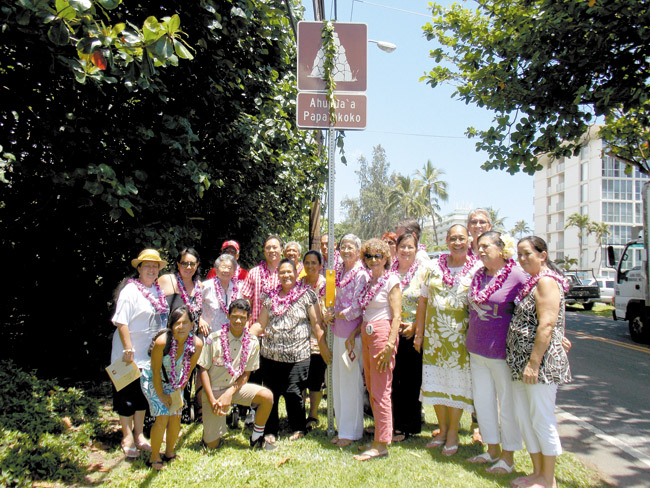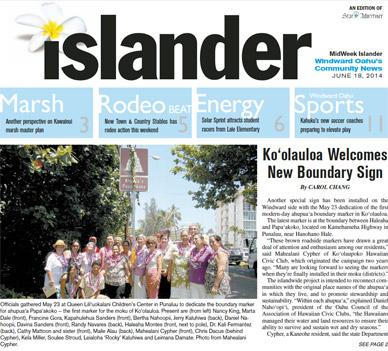Ko‘olauloa Welcomes New Boundary Sign

Officials gathered May 23 at Queen Lili’uokalani Children’s Center in Punaluu to dedicate the boundary marker for ahupua’a Papa’akoko — the first marker for the moku of Ko’olauloa. Present are (from left) Nancy King, Marta Dale (front), Francine Gora, Kapahulehua Sanders (front), Bertha Nahoopii, Jerry Kaluhiwa (back), Daniel Nahoopii, Davina Sanders (front), Randy Navares (back), Haleaha Montes (front, next to pole), Dr. Kali Fermantez (back), Cathy Mattoon and sister (front), Maile Alau (back), Mahealani Cypher (front), Chris Dacus (behind Cypher), Kela Miller, Soulee Stroud, Leialoha ‘Rocky’ Kaluhiwa and Leimana Damate. Photo from Mahealani Cypher.
Another special sign has been installed on the Windward side with the May 23 dedication of the first modern-day ahupua’a boundary marker in Ko’olauloa.
The latest marker is at the boundary between Haleaha and Papa’akoko, located on Kamehameha Highway in Punaluu, near Hanohano Hale.
“These brown roadside markers have drawn a great deal of attention and enthusiasm among our residents,” said Mahealani Cypher of Ko’olaupoko Hawaiian Civic Club, which originated the campaign two years ago. “Many are looking forward to seeing the markers when they’re finally installed in their moku (districts).”
The islandwide project is intended to reconnect communities with the original place names of the ahupua’a in which they live, and to promote stewardship and sustainability. “Within each ahupua’a,” explained Daniel Naho’opi’i, president of the Oahu Council of the Association of Hawaiian Civic Clubs, “the Hawaiians managed their water and land resources to ensure their ability to survive and sustain wet and dry seasons.”
Cypher, a Kaneohe resident, said the state Department of Transportation and city Department of Transportation Services are installing the markers as each community committee determines them and as time permits.
“We’re delighted to work with our communities on this project,” said Francine Gora, the Oahu Council’s project coordinator, “and we learned so much from our cultural practitioners and others who assisted with identifying traditional Hawaiian ahupua’a boundaries for this district.” (Ko’olauloa is comprised of 31 ahupua’a.)
Funders include the Office of Hawaiian Affairs, Harold K.L. Castle Foundation, Hawaii Tourism Authority and Atherton Family Foundation in partnership with Kamehameha Schools, the DOT and city DTS.






